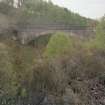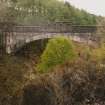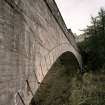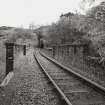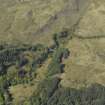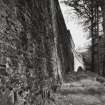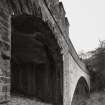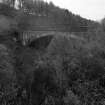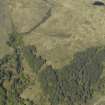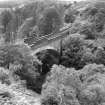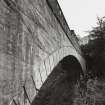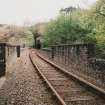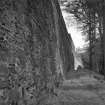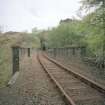Borrodale Viaduct
Railway Viaduct (20th Century)
Site Name Borrodale Viaduct
Classification Railway Viaduct (20th Century)
Alternative Name(s) Borrodale Burn Viaduct; Borrodale Railway Viaduct; Arisaig
Canmore ID 103345
Site Number NM68NE 8
NGR NM 69746 85492
Datum OSGB36 - NGR
Permalink http://canmore.org.uk/site/103345
- Council Highland
- Parish Arisaig And Moidart
- Former Region Highland
- Former District Lochaber
- Former County Inverness-shire
In 1897-1901, making pioneering use of mass concrete, engineers Simpson & Wilson produced for the North British Railway's 40 mile West Highland Line extension a series of bridges, culverts, platforms, retaining walls, 11 tunnels and six viaducts, which have defied corrosion. This monument to concrete engineering earned for its contractor Robert McAlpine the nickname 'Concrete Bob'. Viaducts: six-arched at Arnabol, eight-arched at Loch Nam Uamh (four each side of a great central concrete pylon); three-arched (with rusticated voussoirs) crossing the Brunery Burn at Larachmor and, most daring of all, a central span leaping 12 7.5 ft over a steep gully at Borrodale, twice the span of any existing arch at the time.
Taken from "Western Seaboard: An Illustrated Architectural Guide", by Mary Miers, 2008. Published by the Rutland Press http://www.rias.org.uk
NM68NE 8 69746 85492
For adjacent (to SE) Borrodale Tunnel, see NM69NE 9.
Borrodale Viaduct [NAT]
OS 1:10,000 map, 1975.
(Location cited as NM 698 855). Borrodale Burn Viaduct, opened 1901 by the West Highland Extension Rly. A 3-span mass concrete viaduct, with central 127 ft 6 ins (38.8m) span flanked by single 20 ft (6.1m) spans. In its day was the longest mass-concrete span in the world.
J R Hume 1977.
This viaduct was built to carry the West Highland (Extension) Railway across the valley of the Borrodale Burn. The line was opened to traffic on 1 April 1901, absorbed into the North British Rly on 31 December 1908, and remains in use.
The design of the bridge was governed by the requirements of the owner of Arisaig House (NM68NE 3). It comprises a single concrete arch of 127 ft 6 ins (38.9m) span and a pair of stone-dressed side spans of 20 ft (6.1m) each. At its completion, it was the longest concrete span in the world.
M Smith 1994.
A RCAHMS photographic survey, of Borrodale Railway Viaduct, was undertaken in order to enhance and augment the National Monuments Record Scotland holdings.
Visited by RCAHMS(MKO), July 1997.
This viaduct carries the Fort William - Mallaig ('West Highland Extension') railway over the Borrodale Burn 550m NE of Borrodale House (NM68NE 3).
The location assigned to this record defines the apparent midpoint of the curving structure. The available map evidence suggests that it extends feom NM c. 69780 85482 to NM c. 69644 85502.
Information from RCAHMS (RJCM), 10 May 2006.
Publication Account (2007)
West Highland Extension Railway
(Institute Civil Engineers Historic Engineering Works no. HEW 0084/02)
The West Highland Railway, originally worked by the North British Railway, is one of the world’s most scenic railways. It could also be said to be the last considerable piece of railway building in Britain, its single track
snaking north-west 140 miles from Craigendoran on the Clyde to the fishing port of Mallaig. The 100-mile Craigendoran to Fort William section was begun in 1889 and opened in 1894, and the 40-mile Mallaig extension, was begun in 1897 and completed in 1901.
The Craigendoran–Fort William section was engineered by Formans & McCall, and the main contractor was Lucas & Aird, a prominent London firm whose driving force was John Aird, an MP of crofting stock. The summit is at Corrour, 1345 ft above sea level on Rannoch Moor. The
methods of crossing the waterlogged moor on brushwood were developed from traditional experience.
Spectacular viaducts include Glen Falloch (NN 3170 2020) 145 ft high, and two in the great Horseshoe Curve above Tyndrum (NN 3350 3620).
Financially the line fared precariously during construction and had to be rescued on one occasion by a director, J. H. Renton, using his private fortune. In gratitude his head was sculpted on a massive rock at Rannoch Station by navvies using only the tools of their trade. It is still there.
The Mallaig extension, built to support the fish trade, struggles westwards through inhospitable mountainous country and winding inlets of the sea. The line has gradigradients as steep as 1 in 40 and curves of 12 chains radius (800 ft) both of which impose drastic limits on speed of trains. Much of its length is on embankment, bridges or hewn out of the living rock in cuttings and tunnels. Today the line is a major tourist attraction with many
steam ‘specials’ in addition to regular services. In engineering terms the line is renowned for the early use of mass concrete in bridge construction. The structures were originally planned to be constructed in masonry, but
the local rock ( mica schist) was too hard and difficult to dress. Concrete offered a cheap alternative solution. In consequence of his usage of this material Robert McAlpine became known as ‘Concrete Bob’. The line’s most notable elements are Glenfinnan and Loch nan Uamh viaducts and Borrodale Arch. The railway was designed by Simpson & Wilson, consulting engineers, and the contractor was Robert McAlpine & Co.
R Paxton and J Shipway, 2007.
Reproduced from 'Civil Engineering heritage: Scotland - Highlands and Islands' with kind permission from Thomas Telford Publishers.
Publication Account (2007)
Borrodale Bridge
(Institute Civil Engineers Historic Engineering Works no. HEW 0021/03)
Borrodale Bridge has three arched spans, the central one of 127 1/2ft was said to be the longest concrete arch in the world when built. Its soaring unreinforced-concrete arch, built on a curve in plan, exudes confidence. The rise of the arch is 23 ft and its height above the burn is 80 ft. Its arch-ring, composed of concrete comprising four parts sand and stone to one part cement, is 4 1/2ft thick. The 20 ft side spans were clad in masonry and the bridge was given castellated masonry parapets to mollify a local landowner.























